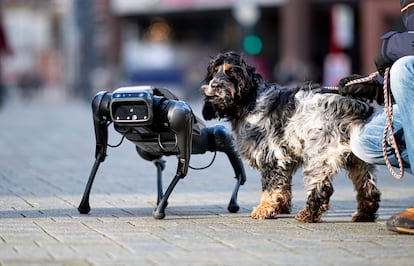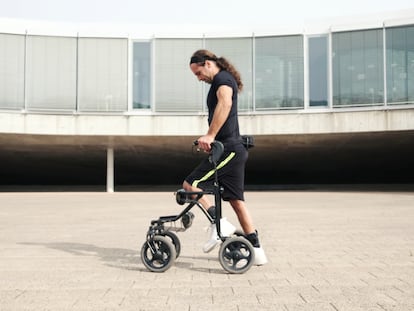Cyberdog: Meet the robot canine from Xiaomi that’s programed to be man’s best friend
The machine, which is on show this week at the MWC 2022, may look like something out of ‘Black Mirror,’ but is actually designed to help seniors or the disabled

“Let’s wake up Albert,” says the Xiaomi employee. And that’s exactly what happens. The plastic and metal body, with its shiny gray back, suddenly jumps up from the floor where it had been lying. It comes to life, or at least starts to move. Its legs look too thin to support its weight, until it suddenly starts to walk across the floor.
The references that we have so far of robotic dogs have not been particularly charming. One of the best known came from Boston Dynamics, the company that ended up being sold to Google, who later sold it on to Japanese group Softbank and then to Hyundai. The early design of these quadruped machines was nothing less than terrifying. A later model, which was more stylish and functional, was not so scary. But its movements were still far from instilling confidence in people.
The Cyberdog from Xiaomi is clearly a better-evolved version. It’s short and it has been programmed with friendly gestures, and is remote controlled using a cellphone app. In the future, the company is hoping that it can be given voice commands. That’s according to Fabio Arena, the product marketing director from Xiaomi, who was speaking to EL PAÍS at the MWC Barcelona, a yearly event for the connectivity industry that is taking place this week in Spain. If that can be done, it would be like giving orders to a real, flesh-and-blood dog, only that it would be able to better understand your wishes thanks to artificial intelligence.
This robotic canine can walk and run up to a certain speed, roll over, and even jump backwards, according to its handlers. It can even be a little threatening: the design does not completely pull it out of the “uncanny valley,” that concept whereby the more realistic robots look like animals or humans, the more unease they cause us. When Cyberdog gets up on his hind legs, it’s hard to know if it’s an act of obedience, as if he were asking for food, or if he’s about to propel himself into the air like a beast from the robot apocalypse. Fortunately, during the demonstration that Xiaomi put on for the press at MWC 2022, it looked more like the former.

But far from being used to scare people, one of the future applications of this machine-canine is to assist seniors or people with disabilities. Thanks to its cameras and artificial intelligence, it can identify who it has to follow. It can also carry a load weighing up to three kilos, whether it be the daily shopping or any other requirement. It can also be used for security purposes, such as patrolling an industrial park.
Smell sensors
For now, the machine is on sale in China to developers, so that they can invent uses for it. It’s also cheaper than you might expect: the equivalent of €1,500 (around $1,670). For the next generation of its robotic dogs, Xiaomi is testing smell sensors, according to the product marketing director. The machine would be able to detect, for example, the odor of onion or garlic.
This electronic specimen bears little relationship to the references that we have from fiction, which do little to help us feel affection for robotic canines. One of the most recent examples of this was in the dystopian TV show Black Mirror, in the ‘Metalhead’ episode in the fourth season. With nightmarish depictions like this one, it’s not easy to feel affection for these beasts. Sorry, machines… sometimes it’s easy to forget what they really are…
Tu suscripción se está usando en otro dispositivo
¿Quieres añadir otro usuario a tu suscripción?
Si continúas leyendo en este dispositivo, no se podrá leer en el otro.
FlechaTu suscripción se está usando en otro dispositivo y solo puedes acceder a EL PAÍS desde un dispositivo a la vez.
Si quieres compartir tu cuenta, cambia tu suscripción a la modalidad Premium, así podrás añadir otro usuario. Cada uno accederá con su propia cuenta de email, lo que os permitirá personalizar vuestra experiencia en EL PAÍS.
¿Tienes una suscripción de empresa? Accede aquí para contratar más cuentas.
En el caso de no saber quién está usando tu cuenta, te recomendamos cambiar tu contraseña aquí.
Si decides continuar compartiendo tu cuenta, este mensaje se mostrará en tu dispositivo y en el de la otra persona que está usando tu cuenta de forma indefinida, afectando a tu experiencia de lectura. Puedes consultar aquí los términos y condiciones de la suscripción digital.
More information
Últimas noticias
The metaverse, four years later: Is it finished or just at a standstill?
$3,000 and a plane ticket: The United States increases incentives for migrants to self-deport before the end of the year
Charles Dubouloz, mountaineering star, retires at 36 with a farewell tour inspired by Walter Bonatti
From the White House to diplomatic gifts: Lego wins over adult fans, brick by brick
Most viewed
- The low-cost creative revolution: How technology is making art accessible to everyone
- Christian Louboutin: ‘Young people don’t want to be like their parents. And if their parents wear sneakers, they’re going to look for something else’
- All the effects of gentrification in one corner of Mexico’s Colonia Roma
- Christmas loses its festive spirit: ICE fears cast shadow over religious celebrations
- Liset Menéndez de la Prida, neuroscientist: ‘It’s not normal to constantly seek pleasure; it’s important to be bored, to be calm’










































